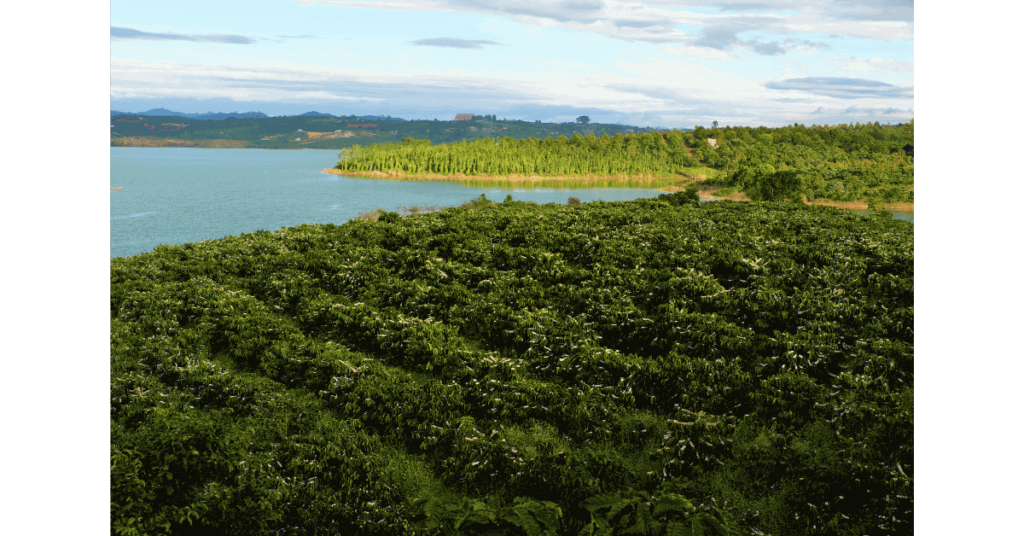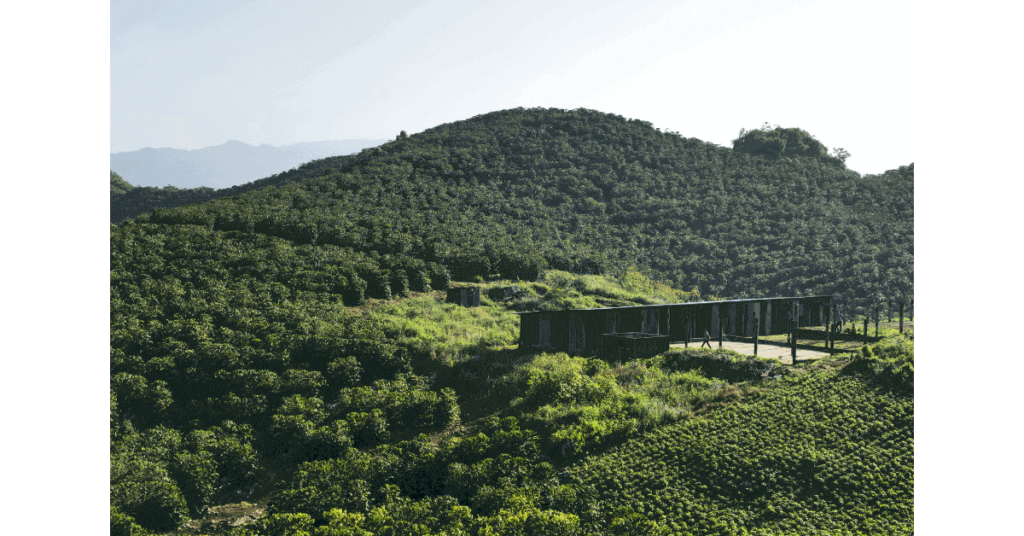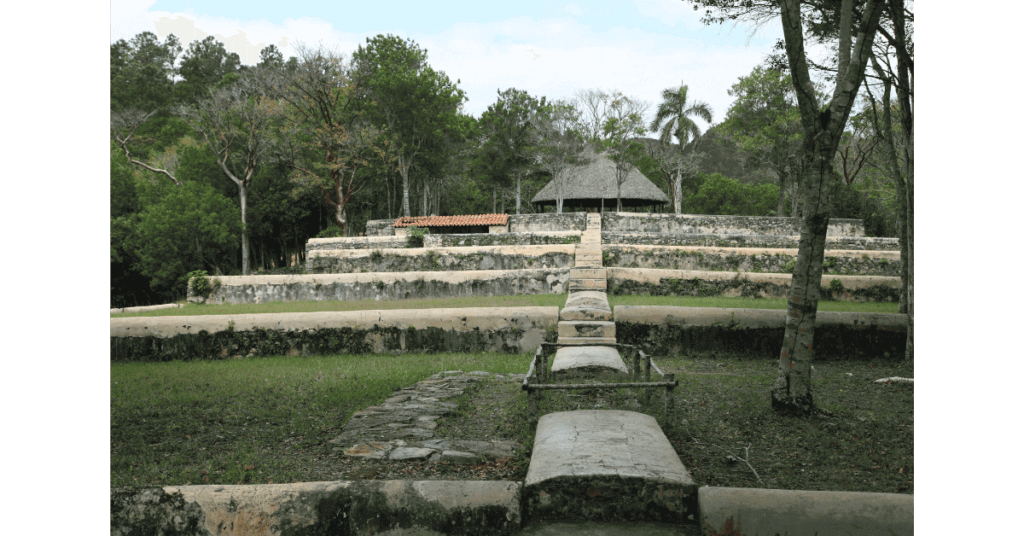This post may contain affiliate links. Please read my disclosure for more info.
Do you dream of tasting single-origin coffee from every corner of the world? That’s my mission too! So, I’ve crafted this detailed guide showcasing coffee production across different countries. It includes insights on bean types, their quality, and other fascinating tidbits I’ve discovered.
Dive into the ultimate guide to the world’s top coffee producers! Let’s explore together and find the best coffee beans out there.
Where is Coffee Grown?
Coffee beans thrive in over 80 countries across South and Central America, Africa, Asia, and the Caribbean.
Coffee is like a world tour in a cup! Every country, even specific areas within them, grows coffee beans that taste and smell unique. This means there’s a special flavor for everyone. Plus, small coffee growers have a chance to shine by finding their own special spot in the coffee market. Isn’t that amazing?
The coffee belt

The coffee belt wraps around the Earth like a cozy ring, right along the equator. It’s where the weather is perfect for growing coffee. Every big coffee country is in this special zone, even though some have tried to grow coffee outside of it.
Coffee Production by Country
| Country | Coffee production (metric tons) |
|---|---|
| Brazil | 2,680,515 |
| Vietnam | 1,542,398 |
| Colombia | 754,376 |
| Indonesia | 668,677 |
| Honduras | 475,042 |
| Ethiopia | 471,247 |
| Peru | 346,466 |
| India | 312,000 |
| Guatemala | 245,441 |
| Uganda | 209,325 |
| Mexico | 153,794 |
| Laos | 150,795 |
| Nicaragua | 128,111 |
| China | 115,150 |
| Ivory Coast | 103,514 |
| Costa Rica | 90,390 |
| Philippines | 62,078 |
| Papua New Guinea | 58,840 |
| Tanzania | 55,789 |
| Madagascar | 47,387 |
| Venezuela | 46,650 |
| Kenya | 40,800 |
| Haiti | 39,537 |
| El Salvador | 39,460 |
| Sierra Leone | 35,720 |
| Thailand | 34,312 |
| Cameroon | 30,984 |
| Democratic Republic of the Congo | 29,912 |
| Bolivia | 21,181 |
| Yemen | 19,514 |
| Togo | 18,476 |
| Rwanda | 17,824 |
| Guinea | 17,813 |
| Angola | 15,436 |
| Dominican Republic | 15,241 |
| Burundi | 14,000 |
| Timor-Leste | 10,827 |
| Central African Republic | 9,355 |
| Myanmar | 8,546 |
| Malawi | 8,420 |
| Malaysia | 8,109 |
| Ecuador | 7,564 |
| Zambia | 6,880 |
| Cuba | 6,306 |
| Jamaica | 6,222 |
| Panama | 5,730 |
| Sri Lanka | 5,437 |
| Equatorial Guinea | 4,272 |
| Puerto Rico | 3,868 |
| Republic of the Congo | 3,197 |
| United States | 2,200 |
| Nigeria | 1,556 |
| Mozambique | 793 |
| Ghana | 727 |
| Zimbabwe | 608 |
| Liberia | 594 |
| Nepal | 466 |
| Paraguay | 442 |
| Guyana | 401 |
| Cambodia | 365 |
| Dominica | 287 |
| Saint Vincent and the Grenadines | 184 |
| Comoros | 140 |
| Gabon | 94 |
| Belize | 80 |
| Benin | 50 |
| Cape Verde | 47 |
| Trinidad and Tobago | 39 |
| Guadeloupe | 31 |
| Martinique | 28 |
| Vanuatu | 26 |
| French Polynesia | 22 |
| Tonga | 16 |
| Samoa | 12 |
| Sao Tome and Principe | 12 |
| Fiji | 9 |
| Suriname | 6 |
| New Caledonia | 5 |
1. Brazil (2,680,515 metric tons)
Since the early 1800s, Brazil has been the top coffee maker globally, stepping in when the Haitian revolution created a huge demand. This sparked Brazil’s coffee craze, hitting its peak in the 1840s when Brazilian coffee beans met 40% of the world’s needs.
Brazil didn’t just have one golden era of coffee. In the late 1800s, they kicked off another, famously dubbed café com leite, or “coffee with milk.” During this time, Brazil was a coffee powerhouse, providing up to 80% of the coffee enjoyed around the globe.
Did you know Brazil is a coffee giant? It grows a third of all coffee globally, mainly the Arabica type, and sells coffee worth $4.6 billion annually. That’s 15% of the coffee traded worldwide! The US snaps up a quarter of Brazil’s coffee, while Germany, Italy, and Japan are also big buyers.
Discover Brazilian coffee’s smooth, creamy texture with hints of chocolate and caramel, and mild acidity.
2. Vietnam (1,542,398 metric tons)
Vietnam is a big player in coffee, coming in second only to rice in its exports. Thanks to reforms in 1986, Vietnamese coffee farmers have thrived, making room for private coffee businesses to grow and flourish.

Brazil might be the king of coffee production, but when it comes to Robusta—a type of coffee bean perfect for your instant morning cup or rich espresso blends—Vietnam takes the crown. This country is a coffee powerhouse, churning out over 95% of its coffee as Robusta. In fact, Vietnam contributes to 40% of the global Robusta supply and 17% of the coffee beans used worldwide.
3. Colombia (754,376 metric tons)
Colombia crafts 8% of global coffee, exclusively Arabica, ranking them second in its production worldwide. Recently, they’ve climbed to the top as the main coffee supplier to the US.
Café de Colombia, a non-profit, shapes Colombia’s coffee world. It backs the coffee trade and uses profits to uplift coffee-growing areas and their communities.
Colombian coffee delights with its nutty scents, fruity hints, citrusy tang, gentle sweetness, and smooth texture.
4. Indonesia (668,677 metric tons)
Indonesia is a coffee giant, second only to Colombia, crafting 7% of global coffee. Most of it, 91%, is robust Robusta, with a dash of Arabica at 9%.
Did you know that Sumatra, in Indonesia, is famous for its coffee beans, especially when they’re dark roasted? These Sumatran coffee beans keep their rich, complex flavors, giving off smokey and toasty notes. Their unique, earthy taste makes them stand out worldwide. If you’re exploring coffee, Sumatran beans are a must-try!
5. Honduras (475,042 metric tons)
Honduras crafts 5% of the world’s coffee, all from rich Arabica beans.
Until recently, Honduras wasn’t a big name in coffee. Challenges with infrastructure made exporting tough, leading to 90% of their coffee being enjoyed at home.
Good news for coffee lovers: Honduras is now a big player in the coffee world, exporting more beans than ever. Thanks to its unique micro-climates, Honduran coffee is a treasure trove of flavors. Imagine sipping on coffee with notes of fruit, vanilla, and hazelnut, plus many more delicious tastes and smells. Dive into the diverse world of Honduran coffee!
6. Ethiopia (471,247 metric tons)
Ethiopia, where Arabica coffee first sprouted, today contributes just 5% to global coffee production. Yet, Ethiopian coffee beans are so prized they account for 10% of the nation’s GDP. Interestingly, it’s the sole type of coffee grown in this African gem.
7. Peru (346,466 metric tons)
Peru has climbed up the ranks in coffee production, now proudly holding the 7th spot. They contribute 4% to the global coffee bean supply.
Peru is a newcomer to the coffee export scene. This is mainly because their infrastructure wasn’t ready for big coffee shipments. Now, they’re stepping up their game.
Peruvian coffee’s are typically medium-bodied with fruity, nutty, and floral notes.
8. India (312,000 metric tons)
Did you know? Before tea took over, India was all about coffee! Yes, you heard it right. India’s coffee story began about 200 years before tea even entered the picture. They were on track to be a coffee powerhouse until the 1870s, when a nasty coffee rust disease made many switch to growing tea instead.
Despite facing challenges, India contributes 3% to global coffee production. Originally known for Arabica, a disease shifted 60% of its coffee to Robusta. Most of this coffee heads to Europe, where it’s mixed into various blends.
9. Guatemala (245,441 metric tons)
In the 1850s, Guatemala’s coffee scene boomed, all thanks to Europe’s new chemical dyes. These dyes caused Guatemala’s dye business to crash, making room for coffee to shine.

Guatemala might only grow 3% of the world’s coffee, but it’s their biggest export. Once, it was 90% of everything they sold abroad!
They mainly grow Arabica beans, known for their top-notch quality and flavors of hazelnut, dark fruits, and rich dark chocolate.
10. Uganda (209,325 metric tons)
Uganda shines as a top producer of Robusta coffee, crafting less than 20% in Arabica. Its Robusta stands out, prized for its unique acidity and delicious chocolate flavors, making it superior to many others.
They’ve recently started focusing on special Arabica varieties, which might shift their coffee production soon. They make up about 2% of the world’s coffee supply.
11. Mexico (153,794 metric tons)
Mexico leads North America in coffee production. However, in recent years, a devastating coffee rust infestation has dramatically cut its output and exports.
Mexico might only make up 2% of the global coffee scene, but it’s all about quality, focusing on Arabica beans. It used to be America’s top coffee supplier until it was overtaken in the late 2010s.
12. Laos (150,795 metric tons)
Laos has made an impressive leap in the coffee world! Not too long ago, they weren’t even in the top 20. Now, they contribute 2% to the global coffee production.
They mainly grow Robusta beans but are now also starting to grow some Arabica.
13. Nicaragua (128,111 metric tons)
Nicaraguan coffee, mainly Arabica, makes up 1% of global coffee.
14. China (115,150 metric tons)
Just like India, China is famous for its tea. But did you know? They also grow coffee, contributing to 1% of the global Arabica supply. While details on their Robusta production are scarce, they definitely produce it too.
15. Ivory Coast (103,514 metric tons)
Ivory Coast mainly grows Robusta coffee, but now they’re also cultivating Arabusta, a cool mix of Arabica and Robusta beans.
16. Costa Rica (90,390 metric tons)
Costa Rica exclusively grows Arabica coffee, as growing other types is against the law there.
Discover the world of Costa Rican coffee beans, celebrated for their exceptional quality. For a long time, they were a cornerstone of Costa Rica’s economy. However, lately, industries like tech, software, and medical devices are beginning to overshadow coffee production.
17. Philippines (62,078 metric tons)
The Philippines is making waves in the coffee world! Just a few years ago, they entered the top 25, and now, they’ve climbed up to an impressive #17.
The Philippines is known for its Robusta beans, but it’s their Liberica beans that really stand out. These beans became a key coffee source after a major leaf rust outbreak in 1890.
18. Papua New Guinea (58,840 metric tons)
Papua New Guinea mainly grows Arabica coffee, with a bit of Robusta in the mix too.
19. Tanzania (55,789 metric tons)
Half of Tanzania’s coffee comes from Arabica plants and half from Robusta, offering a diverse taste experience.
20. Madagascar (47,387 metric tons)
Madagascar is known for its Robusta coffee, but it also grows a little Arabica. What’s really exciting is the island’s 50 wild coffee types, including some with less caffeine, still waiting to be shared with the world.
21. Venezuela (46,650 metric tons)
Venezuela only produecs Arabica coffee.
22. Kenya (40,800 metric tons)
Kenyan coffee, though not widely produced, is a favorite among many. It’s all Arabica beans, known for their superior quality.
23. Haiti (39,537 metric tons)
Once the world’s top coffee maker, Haiti’s journey took a turn after the Haitian revolution. Fires destroyed many coffee farms. Since then, Haiti has faced hurdles like natural disasters and embargoes, making a coffee comeback tough.
Haitian coffee farmers are real fighters. They pushed Haiti to become the third top coffee producer in 1949, but market challenges knocked them down. Lately, farming in Haiti has really struggled, mainly because of tough climate issues like soil erosion and deforestation.
Haiti is making a comeback in the coffee world! Thanks to their commitment to fair trade and quality specialty coffee, socially-conscious drinkers are starting to take notice.
Haiti’s coffee scene is always full of surprises. Never overlook it!
24. El Salvador (39,460 metric tons)
El Salvador specializes in 100% Arabica coffee. But, since the 1970s, their coffee production has dropped significantly, now making six times less coffee than before.
25. Sierra Leone (35,720 metric tons)
Sierra Leone’s coffee scene took a hit in the 90s due to civil war. They’re bouncing back, but still face challenges like not enough workers, poverty, and old tech, keeping them from the top.
26. Thailand (34,312 metric tons)
Thailand is on a mission to shine with its 100% Robusta coffee. Just a short while back, they shot up to the 19th spot in global rankings. Even though they’ve slipped a bit since, keep your eyes on Thailand’s coffee scene. Big things are brewing!
27. Cameroon (30,984 metric tons)
Cameroon grows mostly Robusta (85%) and some Arabica (15%), with its coffee rankings fluctuating recently.
28. Democratic Republic of the Congo (DRC) (29,912 metric tons)
The Democratic Republic of Congo grows two types of coffee: Robusta and Arabica. Sadly, their coffee production plummeted from a peak of 120,000 metric tons because of a civil war in the 1990s and diseases attacking coffee plants.
29. Bolivia (21,181 metric tons)
Bolivia has everything it needs to be a coffee powerhouse – perfect climate and soil. However, its rough landscapes and limited technology and infrastructure have kept it from climbing higher in the coffee world.
30. Yemen (19,514 metric tons)
Mocha coffee gets its name from Mokha, a Yemeni port city crucial to coffee’s journey from Africa to the world.

Yemen, once a top player in growing Arabica beans and a big coffee producer in the 1800s, has faced tough times. Sadly, humanitarian crises have really impacted its coffee industry, taking it off the coffee throne.
31. Togo (18,476 metric tons)
Togo’s coffee production has seen ups and downs, hitting a low of 4,000 tons in the 1980s.
32. Rwanda (17,824 metric tons)
Rwanda is famous for its Arabica coffee, with 95% being the delicious Bourbon variety. Unlike its neighbors with big coffee farms, Rwanda’s coffee comes from small family-owned plots, making it quite special.
33. Guinea (17,813 metric tons)
Guinea is another 100% Robusta producing nation.
34. Angola (15,436 metric tons)
In the 1970s, Angola was a coffee powerhouse, producing over 200,000 metric tons and ranking as the world’s third-largest coffee producer.
The civil war in Angola, which ended Portuguese control, wrecked its coffee farms. Many coffee experts fled to Brazil. Now, Angola’s coffee comeback seems far off. The plants badly need replacing, a huge task that would cost 230 million USD. It’s a big challenge for the country’s coffee future.
35. Dominican Republic (15,241 metric tons)
The Dominican Republic mainly grows Arabica, with a bit of Robusta.
36. Burundi (14,000 metric tons)
Burundi is boosting its Arabica coffee production through significant investments.
37. Timor-Leste (10,827 metric tons)
Despite its small size, Timor Leste (East Timor) is a giant in the coffee world. It’s the top exporter of non-oil goods there, and it stands out globally as the largest producer of single-source organic coffee. Coffee lovers treasure it for its exceptional quality and unique flavor.
38. Central African Republic (9,355 metric tons)
Coffee making in Central Africa has dropped drastically, by two-thirds, since its 1992 peak.
39. Myanmar (8,546 metric tons)
Myanmar’s coffee scene is just starting, but its perfect weather and soil, plus big investments, promise a bright future for its coffee beans.
40. Malawi (8,420 metric tons)
Since 2019, Malawi’s coffee production has dropped by a third, yet the country’s coffee scene is still growing. As a newcomer in the coffee industry, Malawi is a name you’ll be hearing a lot more of in the future.
41. Malaysia (8,109 metric tons)
Malaysia’s coffee production is dropping roughly 18% each year. This is partly because farmers are choosing other crops and facing high costs to produce coffee.
42. Ecuador (7,564 metric tons)
Ecuador’s coffee glory has faded since the 1970s, despite once being a top export.
43. Zambia (6,880 metric tons)
Zambia’s coffee scene is booming! Since the 2017/2018 season, it’s shot up by an impressive 200%. The country’s special Arabica beans are perfect for their goal of becoming a big name in the coffee export world.
44. Cuba (6,306 metric tons)

Discover the world of Cuban coffee brands, known for their Arabica and Robusta beans. Once a coffee powerhouse, exporting over 20,000 metric tons annually in the mid-1900s, Cuba’s coffee industry faced setbacks from the Cuban revolution and US embargo. Today, it’s gradually making a comeback, though it’s still rebuilding its former prestige.
45. Jamaica (6,222 metric tons)
Jamaica’s Blue Mountain coffee is treasured worldwide for its distinctive aroma and sweet flavor. Interestingly, about 80% of it is shipped off to Japan.
46. Panama (5,730 metric tons)
Panama is famous for its Arabica coffee, but they also grow some Robusta, making up about 18% of their crop. Their star coffee, the Geisha varietal, has been a hit since the 1960s, bagging numerous awards. Impressively, a pound of these beans once fetched $1029 at auction!
47. Sri Lanka (5,437 metric tons)
Coffee isn’t a key industry in Sri Lanka anymore.
48. Equatorial Guinea (4,272 metric tons)
Equatorial Guinea’s coffee production has been declining for many years.
49. Puerto Rico (3,868 metric tons)
Puerto Rico leads as America’s top coffee maker, with Hawaii as its main competition. Lately, they’re focusing on crafting unique, high-quality coffees. This shift comes as the land for growing coffee has dramatically decreased by more than 80% in the last 50 years.
50. Republic of the Congo (3,197 metric tons)
Congo’s coffee scene is on the rise, yet there’s still much room for growth.
51. United States (2,200 metric tons)
The stats we’re talking about are all about Hawaiian coffee beans. They don’t count beans from Puerto Rico, another US territory. Some folks have tried growing coffee in California and Georgia, but those are still small-scale efforts.

Kona coffee shines as one of the priciest beans on the globe, a true gem for coffee lovers. With old sugarcane and pineapple fields transforming into coffee farms, there’s an exciting chance for growth in this luxurious coffee scene.
52. Nigeria (1,556 metric tons)
Nigeria’s coffee scene is booming, with big investments revitalizing the industry.
53. Mozambique (793 metric tons)
In the 70s and 80s, Mozambique produced a whopping 1,000 metric tons of coffee. Unfortunately, it’s been less than that ever since.
54. Ghana (727 metric tons)
Ghana grows mainly Robusta coffee; its low altitude makes Arabica hard to cultivate.
55. Zimbabwe (608 metric tons)
Zimbabwe’s coffee scene is making an exciting comeback! After years of struggle with economic challenges and droughts, the country has seen a 50% surge in coffee production since 2018.
56. Liberia (594 metric tons)
Liberia is known for growing Robusta and the unique Liberica coffee beans. At one time, it produced up to 10,000 metric tons of Liberica. However, less demand and civil wars have greatly impacted its coffee industry.
57. Nepal (466 metric tons)
Nepal is home to vast lands perfect for growing coffee, yet much of it is still untouched. With the country facing a higher demand for coffee than what it currently produces, it’s exciting to think about the potential growth in this area.
58. Paraguay (442 metric tons)
Paraguay’s weather and soil are a lot like Brazil’s, great for growing coffee. The coffee scene is blooming, doubling in size since 2006. It’s an exciting time for Paraguay’s coffee!
59. Guyana (401 metric tons)
In the late 1970s, Guyana was producing up to 15,000 metric tons of coffee. But by the late 1990s, that number nearly hit zero. Today, it’s stabilized, with an annual production of 400-500 metric tons.
60. Cambodia (365 metric tons)
Cambodian coffee took a big hit in the 1970s, dropping to just 50 metric tons. But it’s been on the rise ever since, almost back to its old peak.
61. Dominica (287 metric tons)
Since 2017, the small Caribbean island of Dominica has been working hard to bring back its coffee industry. When fully up and running, they aim to produce around 2,000 metric tons of coffee annually.
62. Saint Vincent and the Grenadines (184 metric tons)
For the last few years, Saint Vincent and the Grenadines has been working hard to upgrade its coffee game, aiming to become a key player in the coffee world.
63. Comoros (140 metric tons)
Since the 1970s, Comoros has been producing more coffee, nearly reaching their peak of 180 metric tons.
64. Gabon (94 metric tons)
Gabon mainly produces Robusta beans that it largely sells to France.
65. Belize (80 metric tons)
Belize may not produce a lot of coffee, but its Mayan rainforests provide the perfect cool, shaded environment for growing top-notch coffee beans.
66. Benin (50 metric tons)
Benin’s coffee game has been slipping for 20 years. They used to make nearly 3,000 metric tons of coffee, but now? Only a small slice of that.
67. Cape Verde (47 metric tons)
Cape Verde’s volcanic soil is perfect for coffee, but its dry climate means it won’t produce a lot.
68. Trinidad and Tobago (39 metric tons)
Coffee lovers, listen up! Trinidad and Tobago’s coffee scene has taken a hit from nasty bugs and diseases. Back in 1985, they were brewing up over 2,300 metric tons of coffee. Now? Less than 40. Can you believe it?
69. Guadeloupe (31 metric tons)
Once, Arabica and Liberica beans were stars in Guadeloupe’s economy. But, early 20th-century tropical storms, among other issues, hit the industry hard. For years, it shrank significantly. Today, these coffee farms are mainly a big draw for ecotourism in the country.
70. Martinique (28 metric tons)
Once, Martinique brewed enough coffee to fill every cup in France. Now, this island crafts less than 30 metric tons yearly.
71. Vanuatu (26 metric tons)
Vanuatu’s coffee production is down 90% over the past five decades.
72. French Polynesia (22 metric tons)
Nestled in the southern reaches of French Polynesia, Rimatara Island boasts the most hidden coffee gem on the globe. Here, exotic coffees flourish, celebrated for their top-notch quality and skilled cultivation.
73. Tonga (16 metric tons)
For years, Tonga has consistently produced 10 to 20 metric tons of coffee.
74. Samoa (12 metric tons)
In the 1960s, Samoa was bustling, producing 150 metric tons of coffee. But since the mid-1970s, their coffee production has dipped below 25 metric tons.
75. Sao Tome and Principe (12 metric tons)
In the last 50 years, Sao Tome and Principe’s coffee production dramatically dropped from 300 metric tons to barely 10 metric tons.
76. Fiji (9 metric tons)
Fiji’s coffee production has mostly been low, with just a brief increase in the early 1990s – the reason for that blip is unclear.
77. Suriname (6 metric tons)
In the 1960s, Suriname produced 430 tons of coffee. Now, it makes less than 10 tons.
78. New Caledonia (5 metric tons)
Being last doesn’t mean being least, especially for New Caledonia. Their rare Leroy coffee varietal might not fill every cup, but it shines in competitions and delights everyone lucky enough to taste it. It’s a hidden gem in the coffee world!
Which Country Produces the Most Coffee?
Brazil leads the world in coffee production, holding the top spot for over 150 years. They make 70% more coffee than Vietnam, the second-largest producer. Dive into the world of Brazilian coffee!
Is There Coffee Grown in the US?
Did you know the US is too far north for coffee plants? Except for Hawaii! This sunny state grows its own beans, including the famous Kona coffee, a top-notch favorite among coffee lovers.
Did you know that some US territories grow coffee too? Interestingly, Puerto Rico outshines Hawaii by producing more coffee, making it the top coffee-producing state or territory in the US. Fascinating, right?
The Last Sip
Discover every coffee-producing country here! Think you can find a more extensive list of global coffees? Good luck – you’ll need it!
Ready to discover the world’s finest coffee beans? I’m diving deep into the rich flavors of African, Central American, South American, Caribbean, and Asian coffees. Join me on this flavorful journey across the globe!
Stay tuned and stay caffeinated!



